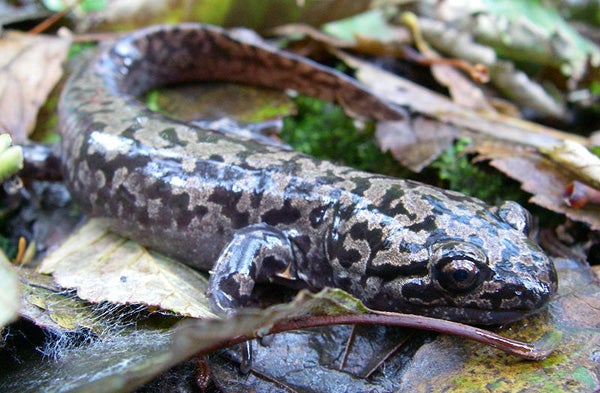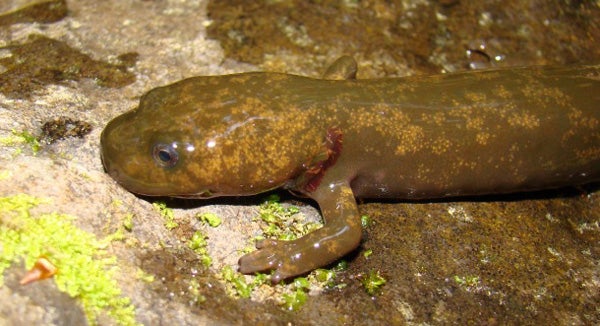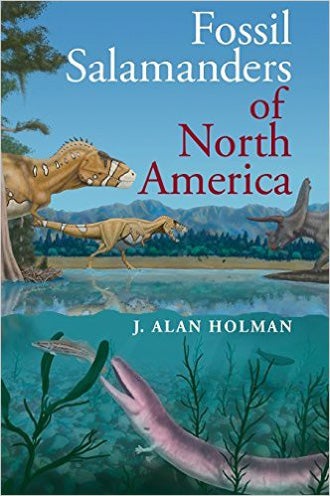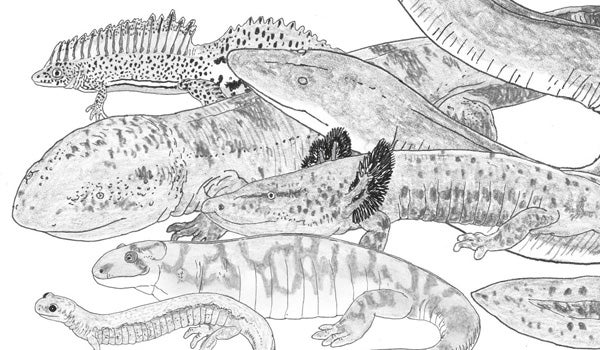This article was published in Scientific American’s former blog network and reflects the views of the author, not necessarily those of Scientific American
Pacific giant salamanders – technically Dicamptodontidae – are a group of big (up to c 30 cm long), robust-skulled North American salamanders with blade-like teeth (though read on for complications about size and distribution brought about by the fossil record). They are well known for their ability to prey on small salamanders as well as rodents and small snakes. They also eat fish on occasion, like juvenile trout and sculpin. They also frequently eat slugs and numerous photos online show them tackling surprisingly large, gaudily yellow banana slugs. They're said to have vocal abilities and to make croaking or barking sounds when threatened, an unexpected talent for a salamander (albeit not a unique one.. have I ever mentioned the weird noises supposedly made by amphiumas?). And they're threatened by habitat destruction – specifically logging – and by the associated degradation of the streams they rely on.

Coastal giant salamander (Dicamptodon tenebrosus) in life. Credit: Jeffrey Marsten Wikimedia
Four extant species are known, all included within Dicamptodon. These are Cope's giant salamander D. copei, the California giant salamander D. ensatus, the Idaho giant salamander D. aterrimus, and the Coastal giant salamander D. tenebrosus. Prior to a 1989 molecular study (Goode 1989), three of these were considered to belong to a single species (D. ensatus), only D. copei being recognised additionally at that time. D. ensatus and D. tenebrosus have a narrow hybrid zone where they meet. Those previously-regarded-as-synonymous species are, indeed, hard to tell apart on the basis of morphology, the main guide to their differentiation being their range. Incidentally, even D. copei is a relatively recent discovery, it first being recognised as distinct in 1970 (Nussbaum 1970).
On supporting science journalism
If you're enjoying this article, consider supporting our award-winning journalism by subscribing. By purchasing a subscription you are helping to ensure the future of impactful stories about the discoveries and ideas shaping our world today.

Larva of Cope's giant salamander photographed on land. Credit: Brad M. Glorioso USGS National Wetlands Research Center
Neoteny (the retention of juvenile features into adulthood) is typical for some members of this group, Cope's giant salamander in particular. In fact fully metamorphosed individuals of this species are extremely rare, less than 10 having been recorded in the wild. Neotenous individuals lack eyelids, retain short, bushy external gills and possess a paddle-like tailfin that extends slightly ahead of the hindlimbs. They are not entirely restricted to the aquatic environment and will wander around on land, especially on wet nights.
Reproduction in these salamanders involves the production of a clutch of 25-115 eggs that are then guarded by the female, healed injuries on the bodies of these mothers indicating sometimes aggressive defence against predators (which are most likely other salamanders). The eggs are laid in hollows under logs or rocks, or in cavities at the sides of water bodies. The literature is somewhat confusing on where these nest sites are located but it appears that the metamorphosing species lay them in the terrestrial environment while Cope's giant salamander lays its eggs in streams and pools.
While it is mostly convention today to recognise a distinct 'family' for this lineage, some authors include them within Ambystomatidae, the mole salamander group that famously includes the axolotl and the barred and tiger salamanders. In current molecular phylogenies, Ambystomatidae and Dicamptodon are sister-groups, so they're close whatever you do.

There aren't many books devoted to fossil salamanders, but this exists at least. Credit: J.A. Holman Amazon
Dicamptodontids are reasonably well represented in the North American fossil record, with specimens known from the Paleocene onwards, some of which have been referred to Dicamptodon itself. Among these is D. antiquus from the Paleocene of Alberta, the type specimen of which is quite good and consists of a near-complete skull, articulated forelimbs and some articulated anterior dorsal vertebrae – it's not just a few vertebrae as is often the case for fossil salamanders. Also intriguing are the Paleocene and Miocene fossil trackways that have been identified as those of Dicamptodon. That's right: fossil salamander tracks, and they can be identified as those of Dicamptodon because this salamander - uniquely - has weird, bilobate palms. The Paleocene Dicamptodon tracks are from Montana and are about twice as big as those of modern Dicamptodon species (Holman 2006).

Representatives of most - but not all - salamander lineages, as illustrated for my textbook project (for more info click HERE). No dicamptodontid yet! Credit: Darren Naish
Also interesting is that alleged fossil dicamptodontids have also been reported from Europe, including Bargmannia. However, there are conflicting opinions on the alleged dicamptodontid identity of these European taxa. Roček (1994) stated that they are members of this group “beyond any doubt” but I get the impression from the literature that other specialists are not so confident. Incidentally, while the name Bargmannia is used widely in the fossil salamander literature, it should be noted that Bargmannia Herre, 1955 – the salamander – is pre-dated by Bargmannia Totton, 1954, a siphonophore.
For previous Tet Zoo articles on salamanders, see...
Spiky-frilled, lek-breeding amphibious salamanders… or ‘newts’
Coprophagy and the giraffe-neck program: more on plethodontids
The USA is still yielding lots of new extant tetrapod species
Nobody Expects the Korean Crevice Salamander UPDATE.. now titled The Korean Crevice Salamander
Refs - -
Goode, D. A. 1989. Hybridization and cryptic species in Dicamptodon (Caudata: Dicamptodontidae). Evolution 43, 728-744.
Nussbaum, R. A. 1970. Dicamptodon copei, n. sp., from the Pacific Northwest, U.S.A. (Amphibia: Caudata: Ambystomatidae). Copeia 1970, 506-514.
Roček, Z. 1994. A review of the fossil Caudata of Europe. Abhandlungen und Berichte für Naturkunde 17, 51-56.